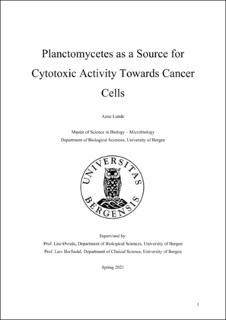| dc.description.abstract | Planctomycetes are a ubiquitous phylum in the bacterial domain. They are known to possess unique traits distinguishing them from other bacteria, such as the formation of rosette aggregates, the lack of FtsZ-protein used in binary fission and the preferred division by budding, large genomes and crateriform structures in the cell wall. The bacteria are found in diverse habitats, including in extreme environments and in association with other organisms such as macroalgae and diatoms. Planctomycetes are therefore presumed to be productive producers of quorum sensing autoinducers and secondary metabolites, which could be useful as bioactive molecules in medicine. In this study, Planctomycetes strains from various habitats were tested for cytotoxic potential towards acute myeloid leukaemia cell line MOLM-13, prostate cancer cell line PC3 and normal rat kidney cell line NRK. The strains were cultivated in M30 medium, harvested and freeze-dried before being tested for cytotoxic activity in aqueous phase and organic phase, using both small and large volumes of biomass. To examine where the cytotoxic potential was located and obtain some knowledge on what kinds of bioactive molecules were responsible for the cytotoxic potential, solid phase extraction (SPE) was conducted. This extracted fractions of aqueous or organic extracts, and separated chemical compounds from the samples. High performance liquid chromatography (HPLC) was conducted to visualize selected SPE on a chromatogram and further separate the SPE into smaller fractions. Experiments using the separated fractions were conducted on the cancer cell lines to investigate which fractions showed cytotoxic potential. Results showed that the Planctomycetes had cytotoxic potential towards both cancer cell lines, with aqueous extracts being most cytotoxic towards MOLM-13 and organic extracts being most cytotoxic towards PC3. Aqueous extracts were found to induce apoptosis in MOLM-13, while organic extracts presumably inhibited cell growth in PC3. The study showed polar and hydrophilic cytotoxic compounds extracted from strain TBK2h. The compounds were either variants of the same substance, or very similar substances. Both hydrophobic and hydrophilic cytotoxic substances were isolated from strain P1a, presumably working together to produce cytotoxicity for the strain. The isolated cytotoxic compounds are scheduled to be chemically analysed to identify known or unknown cytotoxic substances. Sammendrag (engelsk) Planctomycetes are a ubiquitous phylum in the bacterial domain. They are known to possess unique traits distinguishing them from other bacteria, such as the formation of rosette aggregates, the lack of FtsZ-protein used in binary fission and the preferred division by budding, large genomes and crateriform structures in the cell wall. The bacteria are found in diverse habitats, including in extreme environments and in association with other organisms such as macroalgae and diatoms. Planctomycetes are therefore presumed to be productive producers of quorum sensing autoinducers and secondary metabolites, which could be useful as bioactive molecules in medicine. In this study, Planctomycetes strains from various habitats were tested for cytotoxic potential towards acute myeloid leukaemia cell line MOLM-13, prostate cancer cell line PC3 and normal rat kidney cell line NRK. The strains were cultivated in M30 medium, harvested and freeze-dried before being tested for cytotoxic activity in aqueous phase and organic phase, using both small and large volumes of biomass. To examine where the cytotoxic potential was located and obtain some knowledge on what kinds of bioactive molecules were responsible for the cytotoxic potential, solid phase extraction (SPE) was conducted. This extracted fractions of aqueous or organic extracts, and separated chemical compounds from the samples. High performance liquid chromatography (HPLC) was conducted to visualize selected SPE on a chromatogram and further separate the SPE into smaller fractions. Experiments using the separated fractions were conducted on the cancer cell lines to investigate which fractions showed cytotoxic potential. Results showed that the Planctomycetes had cytotoxic potential towards both cancer cell lines, with aqueous extracts being most cytotoxic towards MOLM-13 and organic extracts being most cytotoxic towards PC3. Aqueous extracts were found to induce apoptosis in MOLM-13, while organic extracts presumably inhibited cell growth in PC3. The study showed polar and hydrophilic cytotoxic compounds extracted from strain TBK2h. The compounds were either variants of the same substance, or very similar substances. Both hydrophobic and hydrophilic cytotoxic substances were isolated from strain P1a, presumably working together to produce cytotoxicity for the strain. The isolated cytotoxic compounds are scheduled to be chemically analysed to identify known or unknown cytotoxic substances. | |
